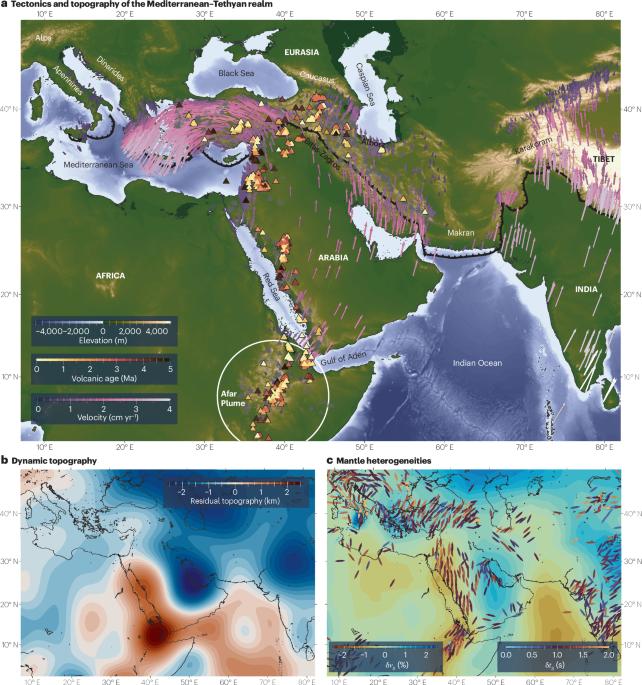Collision, mantle convection and Tethyan closure in the Eastern Mediterranean
引用次数: 0
Abstract
The Tethys Seaway once linked the Atlantic and Indo-Pacific oceans. Its gradual shallowing and closure impacted global ocean circulation, faunal diversification and climatic changes. In this Review, we evaluate the tectonic causes and the topographic changes across the Eastern Mediterranean over the past 66 Ma and explore the consequences of Tethys Seaway closure. Mantle convection led to collisional tectonic processes, mountain building and crustal thickening along the Tethyan realm. The Ethiopian flood basalts mark the arrival of the Afar plume at ~30 Ma, followed by northward-trending volcanic activity indicating that plume material had moved to northwest Arabia by ~20 Ma. Plume-induced mantle flow generated kilometre-scale uplift across East Africa, at ~8° N at ~35 Ma, and along Arabia and led to the formation of the Gomphotherium land bridge at 30° N, ~20 Ma. Afro-Arabian uplift contributed to the development of modern-like Asian monsoons, and the land bridge between Africa and Asia enabled one of the greatest faunal interchanges of the Cenozoic. The gradual shoaling and final closure of the Tethys Seaway likely facilitated the transition towards a stronger overturning circulation in the North Atlantic, contributing to the Cenozoic cooling trend. Future research should incorporate more detailed spatial and temporal uplift models into paleogeography and paleoclimate models to better simulate consequences for ocean circulation, climate and biogeographic dispersals. Closure of the Tethys Seaway marked the last connection between the Atlantic and Indo-Pacific oceans. This Review explores how mantle convection and associated volcanic activity caused Tethys Seaway closure and discusses the implications for ocean circulation, faunal diversification and climate.

东地中海碰撞、地幔对流与特提斯闭合
特提斯海道曾经连接着大西洋和印度洋-太平洋。它的逐渐变浅和关闭影响了全球海洋环流、动物多样性和气候变化。在这篇综述中,我们评估了过去66 Ma东地中海的构造原因和地形变化,并探讨了特提斯海道关闭的后果。地幔对流导致了沿特提斯地区的碰撞构造过程、造山和地壳增厚。埃塞俄比亚洪水玄武岩标志着~30 Ma阿法尔地幔柱的到来,随后是向北的火山活动,表明地幔柱物质在~20 Ma移到了阿拉伯西北部。羽流引起的地幔流在~8°N ~35 Ma的东非和沿阿拉伯半岛产生千米尺度的隆升,并导致了30°N ~20 Ma的Gomphotherium陆桥的形成。非洲-阿拉伯地区的隆起促进了类似现代亚洲季风的发展,非洲和亚洲之间的陆桥使新生代最伟大的动物交换成为可能。特提斯海道的逐渐浅滩化和最终关闭可能促进了北大西洋向更强的翻转环流的转变,导致了新生代的冷却趋势。未来的研究应在古地理和古气候模型中加入更详细的时空隆升模型,以更好地模拟海洋环流、气候和生物地理扩散的后果。特提斯海道的关闭标志着大西洋和印度洋-太平洋之间的最后连接。本文探讨了地幔对流和相关火山活动如何导致特提斯海道关闭,并讨论了其对海洋环流、动物多样性和气候的影响。
本文章由计算机程序翻译,如有差异,请以英文原文为准。
求助全文
约1分钟内获得全文
求助全文

 求助内容:
求助内容: 应助结果提醒方式:
应助结果提醒方式:


